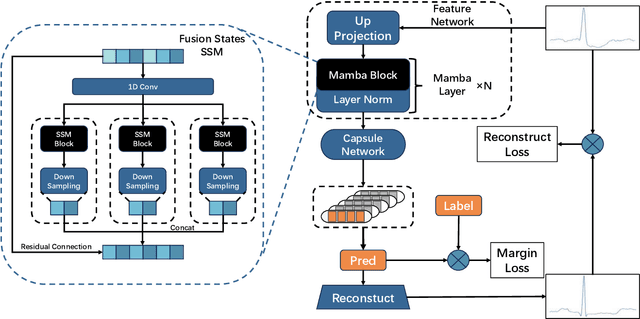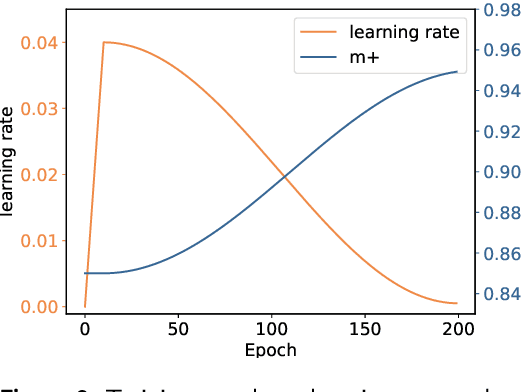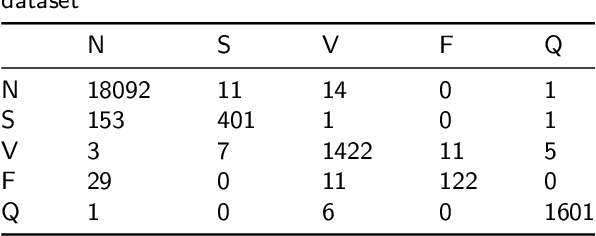Xiaoqiang Liu
MambaCapsule: Towards Transparent Cardiac Disease Diagnosis with Electrocardiography Using Mamba Capsule Network
Jul 30, 2024



Abstract:Cardiac arrhythmia, a condition characterized by irregular heartbeats, often serves as an early indication of various heart ailments. With the advent of deep learning, numerous innovative models have been introduced for diagnosing arrhythmias using Electrocardiogram (ECG) signals. However, recent studies solely focus on the performance of models, neglecting the interpretation of their results. This leads to a considerable lack of transparency, posing a significant risk in the actual diagnostic process. To solve this problem, this paper introduces MambaCapsule, a deep neural networks for ECG arrhythmias classification, which increases the explainability of the model while enhancing the accuracy.Our model utilizes Mamba for feature extraction and Capsule networks for prediction, providing not only a confidence score but also signal features. Akin to the processing mechanism of human brain, the model learns signal features and their relationship between them by reconstructing ECG signals in the predicted selection. The model evaluation was conducted on MIT-BIH and PTB dataset, following the AAMI standard. MambaCapsule has achieved a total accuracy of 99.54% and 99.59% on the test sets respectively. These results demonstrate the promising performance of under the standard test protocol.
LivePortrait: Efficient Portrait Animation with Stitching and Retargeting Control
Jul 03, 2024Abstract:Portrait Animation aims to synthesize a lifelike video from a single source image, using it as an appearance reference, with motion (i.e., facial expressions and head pose) derived from a driving video, audio, text, or generation. Instead of following mainstream diffusion-based methods, we explore and extend the potential of the implicit-keypoint-based framework, which effectively balances computational efficiency and controllability. Building upon this, we develop a video-driven portrait animation framework named LivePortrait with a focus on better generalization, controllability, and efficiency for practical usage. To enhance the generation quality and generalization ability, we scale up the training data to about 69 million high-quality frames, adopt a mixed image-video training strategy, upgrade the network architecture, and design better motion transformation and optimization objectives. Additionally, we discover that compact implicit keypoints can effectively represent a kind of blendshapes and meticulously propose a stitching and two retargeting modules, which utilize a small MLP with negligible computational overhead, to enhance the controllability. Experimental results demonstrate the efficacy of our framework even compared to diffusion-based methods. The generation speed remarkably reaches 12.8ms on an RTX 4090 GPU with PyTorch. The inference code and models are available at https://github.com/KwaiVGI/LivePortrait
The Application of ChatGPT in Responding to Questions Related to the Boston Bowel Preparation Scale
Feb 13, 2024



Abstract:Background: Colonoscopy, a crucial diagnostic tool in gastroenterology, depends heavily on superior bowel preparation. ChatGPT, a large language model with emergent intelligence which also exhibits potential in medical applications. This study aims to assess the accuracy and consistency of ChatGPT in using the Boston Bowel Preparation Scale (BBPS) for colonoscopy assessment. Methods: We retrospectively collected 233 colonoscopy images from 2020 to 2023. These images were evaluated using the BBPS by 3 senior endoscopists and 3 novice endoscopists. Additionally, ChatGPT also assessed these images, having been divided into three groups and undergone specific Fine-tuning. Consistency was evaluated through two rounds of testing. Results: In the initial round, ChatGPT's accuracy varied between 48.93% and 62.66%, trailing the endoscopists' accuracy of 76.68% to 77.83%. Kappa values for ChatGPT was between 0.52 and 0.53, compared to 0.75 to 0.87 for the endoscopists. Conclusion: While ChatGPT shows promise in bowel preparation scoring, it currently does not match the accuracy and consistency of experienced endoscopists. Future research should focus on in-depth Fine-tuning.
MedFMC: A Real-world Dataset and Benchmark For Foundation Model Adaptation in Medical Image Classification
Jun 16, 2023Abstract:Foundation models, often pre-trained with large-scale data, have achieved paramount success in jump-starting various vision and language applications. Recent advances further enable adapting foundation models in downstream tasks efficiently using only a few training samples, e.g., in-context learning. Yet, the application of such learning paradigms in medical image analysis remains scarce due to the shortage of publicly accessible data and benchmarks. In this paper, we aim at approaches adapting the foundation models for medical image classification and present a novel dataset and benchmark for the evaluation, i.e., examining the overall performance of accommodating the large-scale foundation models downstream on a set of diverse real-world clinical tasks. We collect five sets of medical imaging data from multiple institutes targeting a variety of real-world clinical tasks (22,349 images in total), i.e., thoracic diseases screening in X-rays, pathological lesion tissue screening, lesion detection in endoscopy images, neonatal jaundice evaluation, and diabetic retinopathy grading. Results of multiple baseline methods are demonstrated using the proposed dataset from both accuracy and cost-effective perspectives.
 Add to Chrome
Add to Chrome Add to Firefox
Add to Firefox Add to Edge
Add to Edge